Cross-Layer Energy Optimization for IoT Environments: Technical Advances and Opportunities
Abstract
:1. Introduction
- Firstly, the significance of cross-layer energy optimization in IoT environments is highlighted focusing on different use case implementations.
- Secondly, following the layered taxonomy, a model-based qualitative review is carried out on energy optimization in IoT environments focusing on major functional components, strengths and weaknesses.
- Finally, open research issues and challenges in energy optimization for IoT are identified as future research and development directions in the area.
2. Significance of Energy Efficiency in IoT Use Cases
2.1. Case Study: Smart Home
2.2. Case Study: Smart Car
2.3. Case Study: Smart Logistics
2.4. Case Study: Smart Agriculture
2.5. Case Study: Smart Fabric
2.6. Simulation Oriented Characterization
3. Related Literature Reviews
4. Energy Efficient Techniques in the IoT
4.1. Energy Efficient Techniques at Sensing Layer
4.1.1. Energy Efficient Sleep/Wakeup Techniques
4.1.2. Energy Efficient Modulation Techniques
4.1.3. Energy Efficient Self-Organized Things (SOT)-Based Techniques
4.2. Energy Efficient Techniques at Local Processing and Storage Layer
4.2.1. Energy Harvesting Techniques
4.2.2. Energy Efficient Cognitive Radio Based Techniques
4.3. Energy Efficient Techniques at Network/Communication Layer
4.3.1. Energy Efficient Scheduling Techniques
4.3.2. Energy Efficient Routing Techniques
- energy = energy, and weak links = weak links
- energy < energy, and weak links weak links
- energy > energy, energy ≤ energy , and weak links weak links
4.3.3. Energy Efficient Communication Techniques
4.4. Energy Efficient Cloud Computing Techniques
4.4.1. Energy Efficient Virtual Machine Optimization Techniques
4.4.2. Energy Efficient Lyapunov Optimization Techniques
4.5. Energy Efficient Techniques at the Application Layer
5. Open Research Issues in Energy Oriented IoT
6. Conclusions
Author Contributions
Conflicts of Interest
References
- Zanella, A.; Bui, N.; Castellani, A.; Vangelista, L.; Zorzi, M. Internet of things for smart cities. IEEE Internet Things J. 2014, 1, 22–32. [Google Scholar] [CrossRef]
- Kamalinejad, P.; Mahapatra, C.; Sheng, Z.; Mirabbasi, S.; Leung, V.C.M.; Guan, Y.L. Wireless energy harvesting for the Internet of things. IEEE Commun. Mag. 2015, 53, 102–108. [Google Scholar] [CrossRef]
- Kaiwartya, O.; Abdullah, A.H.; Cao, Y.; Prasad, A.M.; Lin, C.; Liu, X. Internet of Vehicles: Motivation, Layered Architecture, Network Model, Challenges and Future Aspects. IEEE Access 2016, 4, 5356–5373. [Google Scholar] [CrossRef]
- Grieco, L.A.; Rizzo, A.; Colucci, S.; Sicari, S.; Piro, G.; Paola, D.D.; Boggia, G. IoT-aided robotics applications: Technological implications, target domains and open issues. Comput. Commun. 2014, 54, 32–47. [Google Scholar] [CrossRef]
- Aijaz, A.; Aghvami, A.H. Cognitive Machine-to-Machine Communications for Internet-of-Things: A Protocol Stack Perspective. IEEE Internet Things J. 2015, 2, 103–112. [Google Scholar] [CrossRef]
- Lin, Y.B. EasyConnect: A Management System for IoT Devices and Its Applications for Interactive Design and Art. IEEE Internet Things J. 2015, 2, 551–561. [Google Scholar] [CrossRef]
- Bello, O.; Zeadally, S. Intelligent Device Communication in the Internet of Things. Syst. J. IEEE 2014, 10, 1172–1182. [Google Scholar] [CrossRef]
- Evans, D. The Internet of Things: How the Next Evolution of the Internet is Changing Everything; Cisco IBSG: San Francisco, CA, USA, 2011. [Google Scholar]
- Atzori, L.; Iera, A.; Morabito, G. The Internet of Things: A Survey. Comput. Netw. 2010, 54, 2787–2805. [Google Scholar] [CrossRef]
- Kaur, N.; Sood, S.K. An Energy-Efficient Architecture for the Internet of Things (IoT). IEEE Syst. J. 2017, 11, 796–805. [Google Scholar] [CrossRef]
- Erol-Kantarci, M.; Mouftah, H.T. Energy-efficient information and communication infrastructures in the smart grid: A survey on interactions and open Issues. IEEE Commun. Surv. Tutor. 2015, 17, 179–197. [Google Scholar] [CrossRef]
- Machine-to-Machine Communications (M2M). M2M Service Requirements. Available online: http://www.etsi.org/deliver/etsi_ts/102600_102699/102689/01.01.01_60/ts_102689v010101p.pdf (accessed on 14 August 2017).
- Khan, M.; Silva, B.N.; Han, K. Internet of Things Based Energy Aware Smart Home Control System. IEEE Access 2016, 4, 7556–7566. [Google Scholar] [CrossRef]
- Huang, S.C.; Chen, B.H.; Chou, S.K.; Hwang, J.N.; Lee, K.H. Smart Car [Application Notes]. IEEE Comput. Intell. Mag. 2016, 11, 46–58. [Google Scholar] [CrossRef]
- Kant, K.; Pal, A. Internet of Perishable Logistics. IEEE Internet Comput. 2017, 21, 22–31. [Google Scholar] [CrossRef]
- Roopaei, M.; Rad, P.; Choo, K.K.R. Cloud of Things in Smart Agriculture: Intelligent Irrigation Monitoring by Thermal Imaging. IEEE Cloud Comput. 2017, 4, 10–15. [Google Scholar] [CrossRef]
- Tröster, G. Smart Clothes—The Unfulfilled Pledge? IEEE Pervasive Comput. 2011, 10, 87–89. [Google Scholar] [CrossRef]
- Al-Fuqaha, A.; Guizani, M.; Mohammadi, M.; Aledhari, M.; Ayyash, M. Internet of Things: A Survey on Enabling Technologies, Protocols, and Applications. IEEE Commun. Surv. Tutor. 2015, 17, 2347–2376. [Google Scholar] [CrossRef]
- Lin, J.; Yu, W.; Zhang, N.; Yang, X.; Zhang, H.; Zhao, W. A Survey on Internet of Things: Architecture, Enabling Technologies, Security and Privacy, and Applications. IEEE Internet Things J. 2017, 4, 1125–1142. [Google Scholar] [CrossRef]
- Perera, C.; Liu, C.H.; Jayawardena, S.; Chen, M. A Survey on Internet of Things From Industrial Market Perspective. IEEE Access 2014, 2, 1660–1679. [Google Scholar] [CrossRef]
- Kamilaris, A.; Pitsillides, A. Mobile Phone Computing and the Internet of Things: A Survey. IEEE Internet Things J. 2016, 3, 885–898. [Google Scholar] [CrossRef]
- Tokognon, C.A.; Gao, B.; Tian, G.Y.; Yan, Y. Structural Health Monitoring Framework Based on Internet of Things: A Survey. IEEE Internet Things J. 2017, 4, 619–635. [Google Scholar] [CrossRef]
- Razzaque, M.A.; Jevric, M.M.; Palade, A.; Clarke, S. Middleware for Internet of Things: A Survey. IEEE Internet Things J. 2016, 3, 70–95. [Google Scholar] [CrossRef]
- Luong, N.C.; Hoang, D.T.; Wang, P.; Niyato, D.; Kim, D.I.; Han, Z. Data Collection and Wireless Communication in Internet of Things (IoT) Using Economic Analysis and Pricing Models: A Survey. IEEE Commun. Surv. Tutor. 2016, 18, 2546–2590. [Google Scholar] [CrossRef]
- Perera, C.; Zaslavsky, A.; Christen, P.; Georgakopoulos, D. Context Aware Computing for The Internet of Things: A Survey. IEEE Commun. Surv. Tutor. 2014, 16, 414–454. [Google Scholar] [CrossRef]
- Khan, A.A.; Rehmani, M.H.; A. Rachedi, A. Cognitive-Radio-Based Internet of Things: Applications, Architectures, Spectrum Related Functionalities, and Future Research Directions. IEEE Wirel. Commun. 2017, 24, 17–25. [Google Scholar] [CrossRef]
- Ahmed, E.; Yaqoob, I.; Gani, A.; Imran, M.; Guizani, M. Internet-of-things-based smart environments: State of the art, taxonomy, and open research challenges. IEEE Wirel. Commun. 2016, 23, 10–16. [Google Scholar] [CrossRef]
- Cao, Y.; Jiang, T.; Han, Z. A Survey of Emerging M2M Systems: Context, Task, and Objective. IEEE Internet Things J. 2016, 3, 1246–1258. [Google Scholar] [CrossRef]
- Rajandekar, A.; B. Sikdar, A. Survey of MAC Layer Issues and Protocols for Machine-to-Machine Communications. IEEE Internet Things J. 2015, 2, 175–186. [Google Scholar] [CrossRef]
- Botta, A.; Donato, W.; Persico, V.; Pescape, A. Integration of Cloud computing and Internet of Things: A survey. Future Gener. Comput. Syst. 2016, 56, 684–700. [Google Scholar] [CrossRef]
- Stojkoska, B.L.R.; Trivodaliev, K.V. A review of Internet of Things for smart home: Challenges and solutions. J. Clean. Prod. 2017, 140, 1454–1464. [Google Scholar] [CrossRef]
- Liu, C.H.; Fan, J.; Branch, J.W.; Leung, K.K. Toward QoI and Energy-Efficiency in Internet-of-Things Sensory Environments. IEEE Trans. Emerg. Top. Comput. 2014, 2, 473–487. [Google Scholar] [CrossRef]
- Du, R.; Gkatzikis, L.; Fischione, C.; Xiao, M. Energy Efficient Sensor Activation for Water Distribution Networks Based on Compressive Sensing. IEEE J. Sel. Areas Commun. 2015, 33, 2997–3010. [Google Scholar] [CrossRef]
- Chen, Y.; Chiotellis, N.; Chuo, L.X.; Pfeiffer, C.; Shi, Y.; Dreslinski, R.G.; Kim, H.S. Energy-Autonomous Wireless Communication for Millimeter-Scale Internet-of-Things Sensor Nodes. IEEE J. Sel. Areas Commun. 2016, 34, 3962–3977. [Google Scholar] [CrossRef]
- Akgul, O.U.; Canberk, B. Self-Organized Things (SoT): An energy efficient next generation network management. Comput. Commun. 2016, 74, 52–62. [Google Scholar] [CrossRef]
- Ahn, J.H.; Lee, T.J. ALLYS: All You can Send for Energy Harvesting Networks. IEEE Trans. Mob. Comput. 2017. [Google Scholar] [CrossRef]
- Mondal, S.; Paily, R. Efficient Solar Power Management System for Self-Powered IoT Node. IEEE Trans. Circuits Syst. I Regul. Pap. 2017, 64, 2359–2369. [Google Scholar] [CrossRef]
- Qureshi, F.F.; Iqbal, R.; Asghar, M.N. Energy efficient wireless communication technique based on Cognitive Radio for Internet of Things. J. Netw. Comput. Appl. 2017, 89, 14–25. [Google Scholar] [CrossRef]
- Nguyen, T.D.; Khan, J.Y.; Ngo, D.T. Energy harvested roadside IEEE 802.15.4 wireless sensor networks for IoT applications. Ad Hoc Netw. 2017, 56, 109–121. [Google Scholar] [CrossRef]
- Khanouche, M.E.; Amirat, Y.; Chibani, A.; Kerkar, M.; Yachir, A. Energy-Centered and QoS-Aware Services Selection for Internet of Things. IEEE Trans. Autom. Sci. Eng. 2016, 13, 1256–1269. [Google Scholar] [CrossRef]
- Afzal, B.; Alvi, S.A.; Shah, G.A.; Mahmood, W. Energy efficient context aware traffic scheduling for IoT applications. Ad Hoc Netw. 2017, 62, 101–115. [Google Scholar] [CrossRef]
- Song, L.; Chai, K.K.; Chen, Y.; Schormans, J.; Loo, J.; Vinel, A. QoS-Aware Energy-Efficient Cooperative Scheme for Cluster-Based IoT Systems. IEEE Syst. J. 2017, 1447–1455. [Google Scholar] [CrossRef]
- Park, S.; Cho, S.; Lee, J. Energy-Efficient Probabilistic Routing Algorithm for Internet of Things. Available online: http://www.ietf.org/rfc/rfc3561.txt (accessed on 14 August 2017).
- Machado, K.; Rosário, D.; Cerqueira, E.; Loureiro, A.A.F.; Neto, A.; Desouza, J.N. A Routing Protocol Based on Energy and Link Quality for Internet of Thing Applications. Sensors 2013, 13, 1942–1964. [Google Scholar] [CrossRef] [PubMed]
- Chellouge, S. Energy-Efficient Content-Based Routing in Internet of Things. J. Comput. Commun. Sci. Res. 2015, 3, 9–20. [Google Scholar] [CrossRef]
- Zhao, M.; Ho, I.W.H.; Chong, P.H.J. An Energy-Efficient Region-Based RPL Routing Protocol for Low-Power and Lossy Networks. IEEE Internet Things J. 2016, 3, 1319–1333. [Google Scholar] [CrossRef]
- Qiu, T.; Lv, Y.; Xia, F.; Chen, N.; Wan, J.; Tolba, A. An Efficient Routing Protocol for Emergency Response Internet of Things. J. Netw. Comput. Appl. 2016, 72, 104–112. [Google Scholar] [CrossRef]
- Liu, Y.; Liu, A.; Hu, Y.; Li, Z.; Choi, Y.-J.; Sekiya, H.; Li, J. FFSC: An Energy Efficiency Communications Approach for Delay Minimizing in Internet of Things. IEEE Access 2016, 4, 3775–3793. [Google Scholar] [CrossRef]
- Qiu, S.; Haselmayr, W.; Li, B.; Zhao, C.; Guo, W. Bacterial Relay for Energy Efficient Molecular Communications. IEEE Trans. Nanobiosci. 2017, 16, 555–562. [Google Scholar] [CrossRef] [PubMed]
- Biason, A.; Pielli, C.; Rossi, M.; Zanella, A.; Zordan, D.; Kelly, M.; Zorzi, M. EC-CENTRIC: An Energy- and Context-Centric Perspective on IoT Systems and Protocol Design. IEEE Access 2017, 5, 6894–6908. [Google Scholar] [CrossRef]
- Huang, Z.; Lin, K.J.; Yu, S.Y.; Hsu, J.Y. Co-locating services in IoT systems to minimize the communication energy cost. J. Innov. Digit. Ecosyst. 2014, 1, 47–57. [Google Scholar] [CrossRef]
- Kwak, J.; Kim, Y.; Lee, J.; Chong, S. DREAM: Dynamic Resource and Task Allocation for Energy Minimization in Mobile Cloud Systems. IEEE J. Sel. Areas Commun. 2015, 33, 2510–2523. [Google Scholar] [CrossRef]
- Sharkh, M.A.; Shami, A. An evergreen cloud: Optimizing energy efficiency in heterogeneous cloud computing architectures. Veh. Commun. 2017, 9, 199–210. [Google Scholar] [CrossRef]
- Bui, D.M.; Yoon, Y.; Huh, E.N.; Jun, S.; Lee, S. Energy efficiency for cloud computing system based on predictive optimization. J. Parallel Distrib. Comput. 2017, 102, 103–114. [Google Scholar] [CrossRef]
- Liu, A.; Zhang, Q.; Li, Z.; Choi, Y.; Li, J.; Komuro, N. A green and reliable communication modeling for industrial internet of things. Comput. Electr. Eng. 2017, 58, 364–381. [Google Scholar] [CrossRef]
- Kim, J. Energy-Efficient Dynamic Packet Downloading for Medical IoT Platforms. IEEE Trans. Ind. Inform. 2015, 11, 1653–1659. [Google Scholar] [CrossRef]
- Chiu, T.C.; Shih, Y.Y.; Pang, A.C.; Pai, C.W. Optimized Day-Ahead Pricing With Renewable Energy Demand-Side Management for Smart Grids. IEEE Internet Things J. 2017, 4, 374–383. [Google Scholar] [CrossRef]
- Gandotra, P.; Jha, R.K.; Jain, S. Green Communication in Next Generation Cellular Networks: A Survey. IEEE Access 2017, 5, 11727–11758. [Google Scholar] [CrossRef]
- Wang, K.; Alonso-Zarate, J.; Dohler, M. Energy-efficiency of LTE for small data machine-to-machine communications. In Proceedings of the 2013 IEEE International Conference on Communications (ICC), Budapest, Hungary, 9–13 June 2013. [Google Scholar]
- Liu, M.; Crussière, M.; Hélard, J.-F. Improved physical layer for energy-efficient M2M communications over cellular networks. In Proceedings of the 2015 23rd International Conference on Software, Telecommunications and Computer Networks (SoftCOM), Split, Croatia, 16–18 September 2015. [Google Scholar]
- Li, J.; Peng, M.; Yu, Y.; Ding, Z. Energy-Efficient Joint Congestion Control and Resource Optimization in Heterogeneous Cloud Radio Access Networks. IEEE Trans. Veh. Technol. 2016, 65, 9873–9887. [Google Scholar] [CrossRef]
- Sendra Compte, S.; Lloret, J.; García Pineda, M.; Toledo Alarcón, J.F. Power saving and energy optimization techniques for Wireless Sensor Networks. J. Commun. 2011, 6, 439–459. [Google Scholar] [CrossRef]
- Kaiwartya, O.; Abdullah, A.H.; Cao, Y.; Lloret, J.; Kumar, S.; Shah, R.R.; Prasad, M.; Prakash, S. Virtualization in Wireless Sensor Networks: Fault Tolerant Embedding for Internet of Things. IEEE Internet Things J. 2017. [CrossRef]
- Garcia, M.; Sendra, S.; Lloret, J.; Canovas, A. Saving energy and improving communications using cooperative group-based wireless sensor networks. Telecommun. Syst. 2013, 52, 2489–2502. [Google Scholar] [CrossRef]
- Kaiwartya, O.; Abdullah, A.H.; Cao, Y.; Raw, R.S.; Kumar, S.; Lobiyal, D.K.; Isnin, I.F.; Liu, X.; Shah, R.R. T-MQM: Testbed-based multi-metric quality measurement of sensor deployment for precision agriculture—A case study. IEEE Sens. J. 2016, 16, 8649–8664. [Google Scholar] [CrossRef]
- Alrajeh, N.A.; Khan, S.; Lloret, J.; Loo, J. Secure routing protocol using cross-layer design and energy harvesting in wireless sensor networks. Int. J. Distrib. Sens. Netw. 2013, 9, 374796. [Google Scholar] [CrossRef]
- Li, Y.; Zhou, G.; PenG, G. Energy Modeling and Optimization for BSN and WiFi Networks Using Joint Data Rate Adaptation. Adhoc Sens. Wirel. Netw. 2016, 32, 149–173. [Google Scholar]
- Mehmood, A.; Khan, S.; Shams, B.; Lloret, J. Energy-efficient multi-level and distance-aware clustering mechanism for WSNs. Int. J. Commun. Syst. 2015, 28, 972–989. [Google Scholar] [CrossRef]
- Kim, S. Game Based Certificate Revocation Algorithm for Internet of Things Security Problems. Adhoc Sens. Wirel. Netw. 2016, 32, 319–336. [Google Scholar]
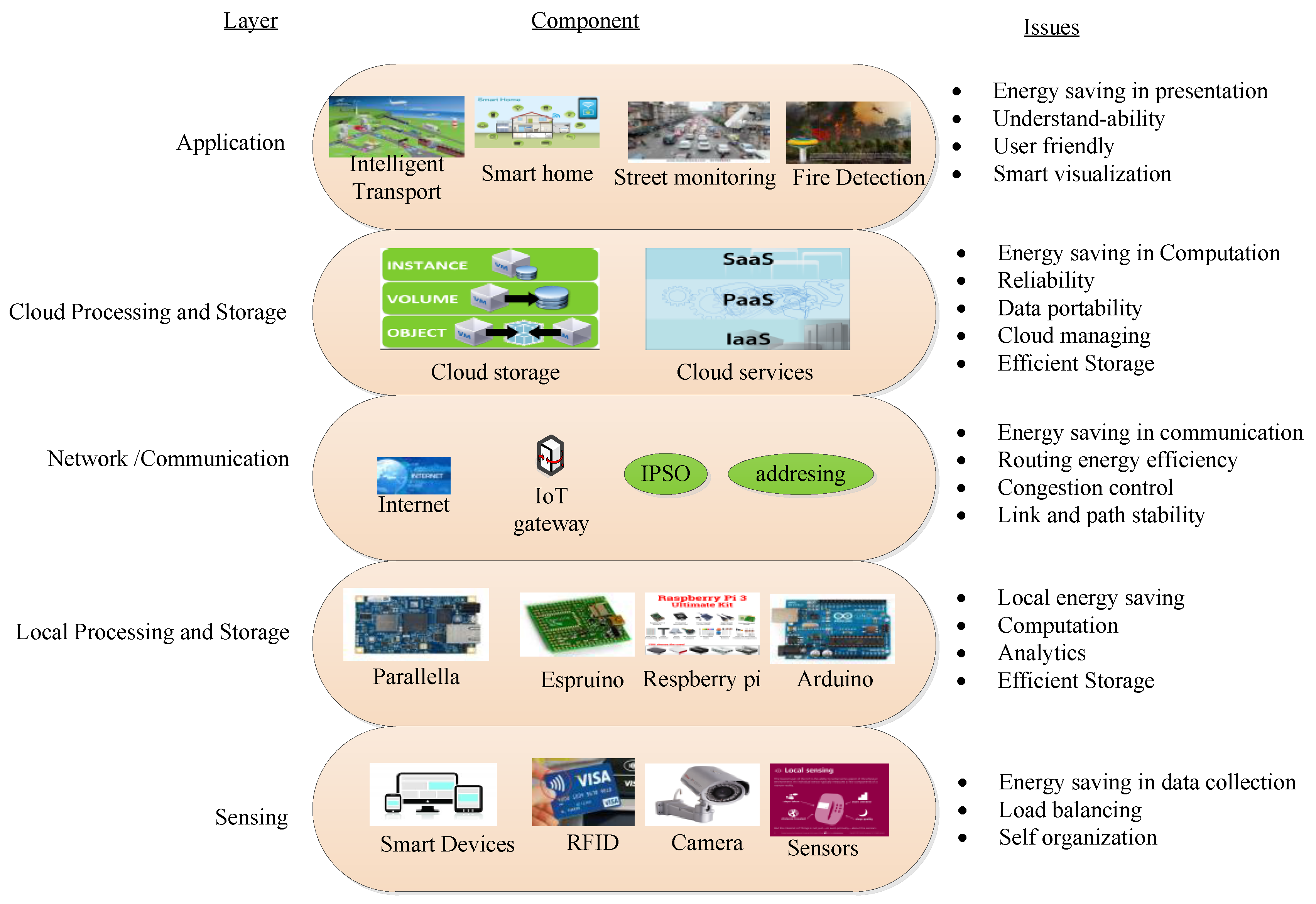
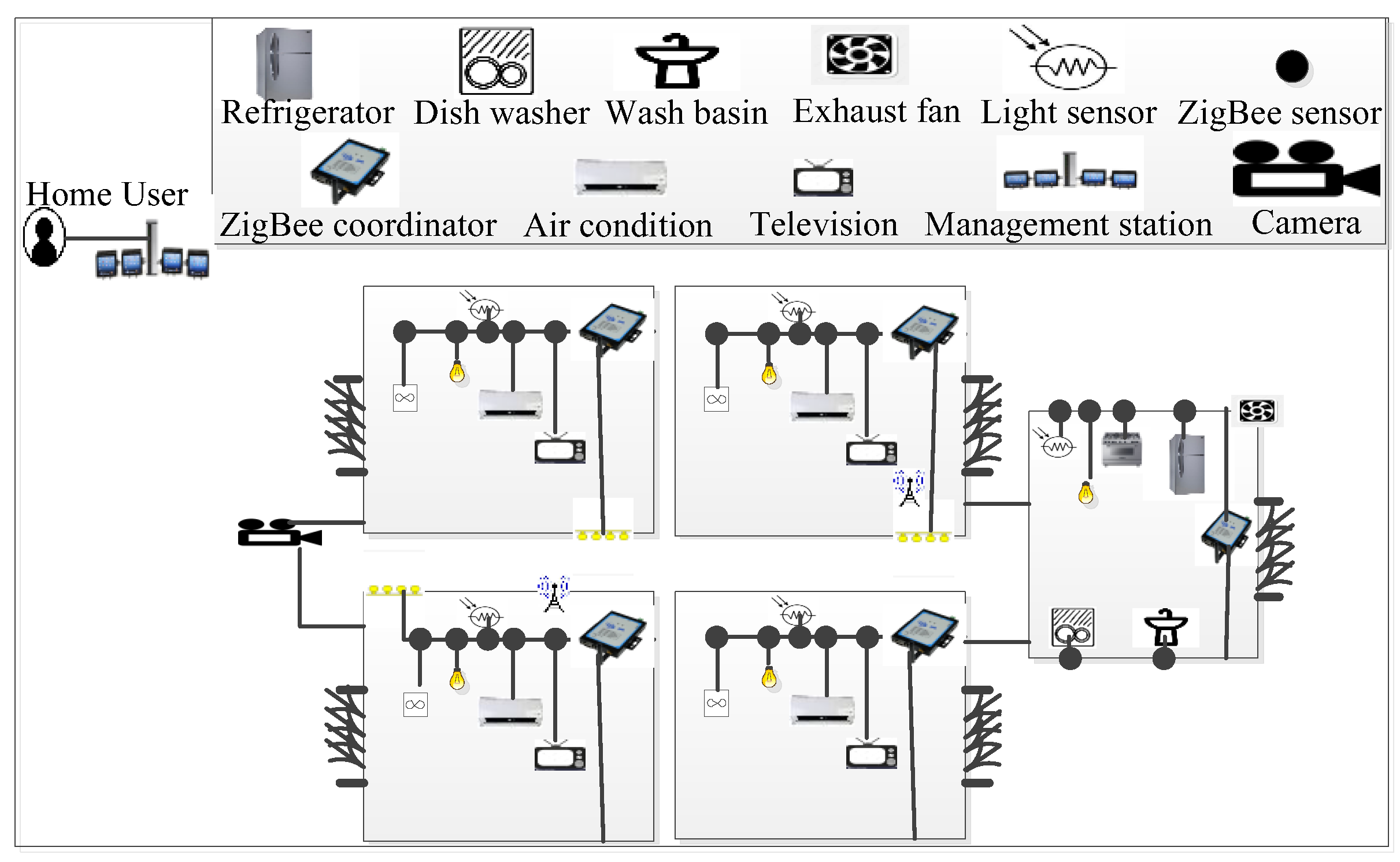
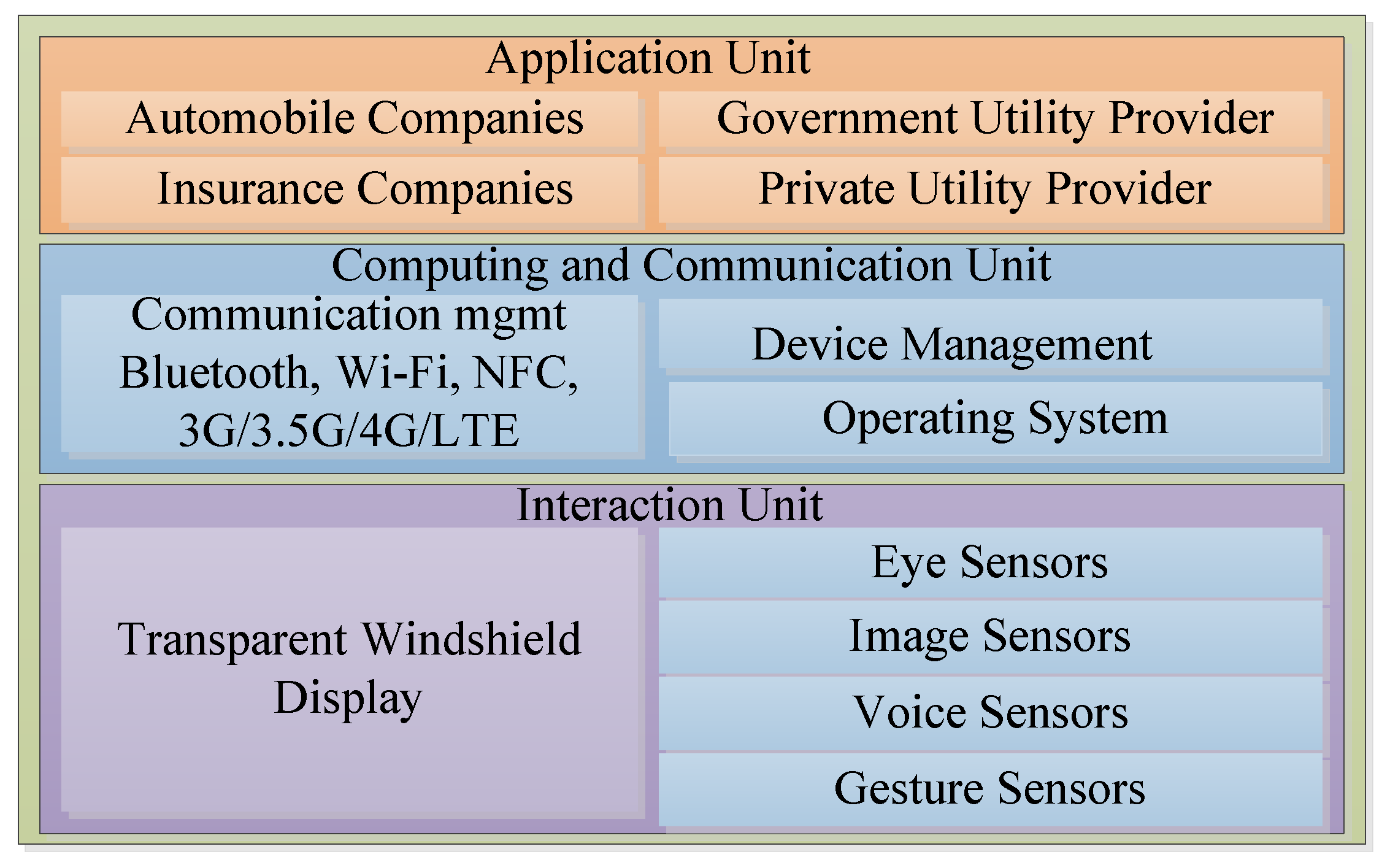
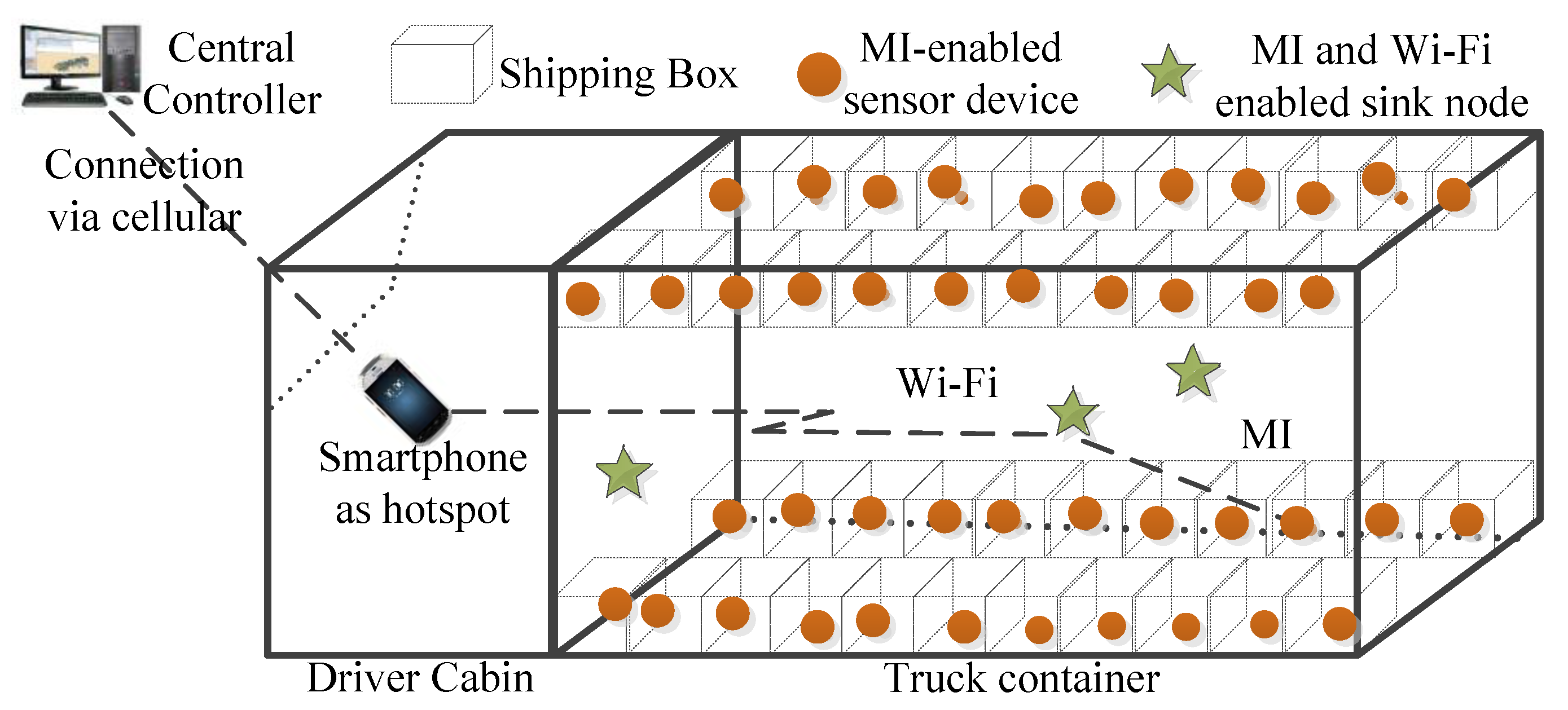

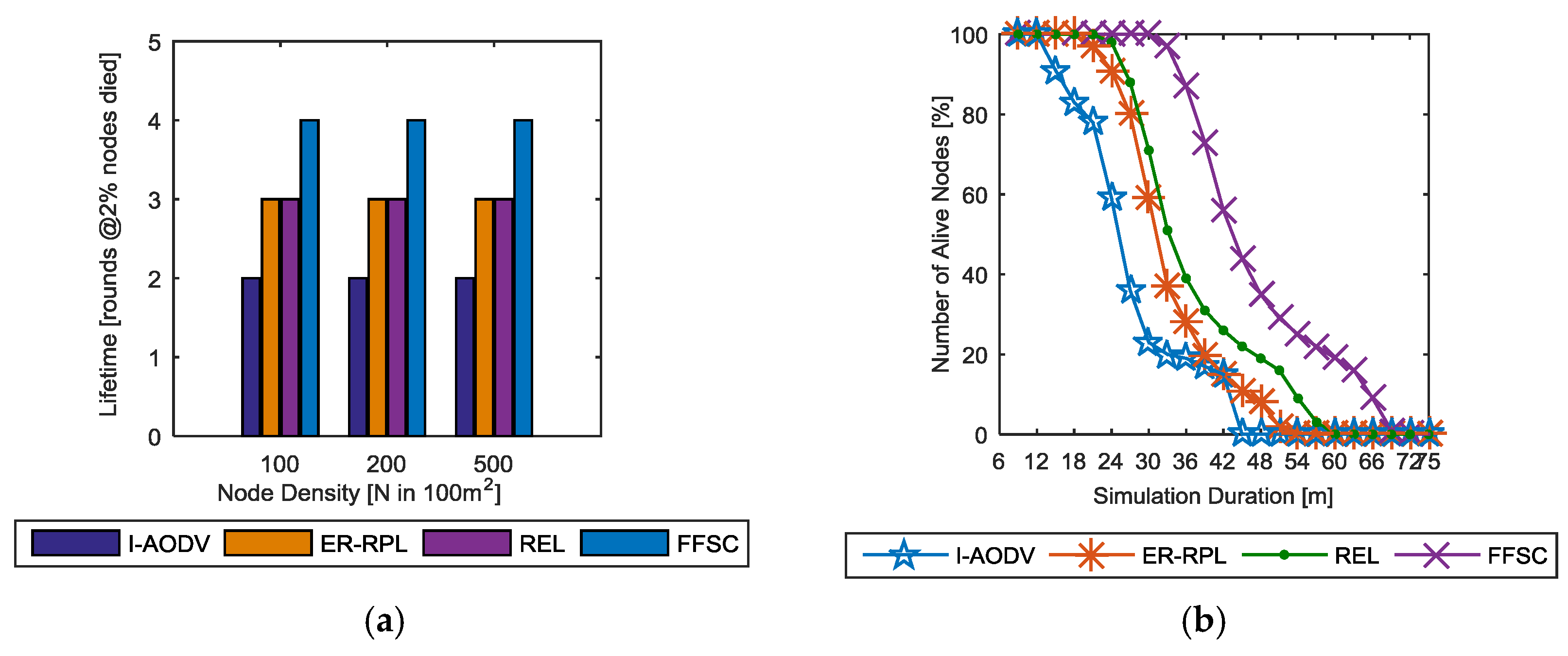
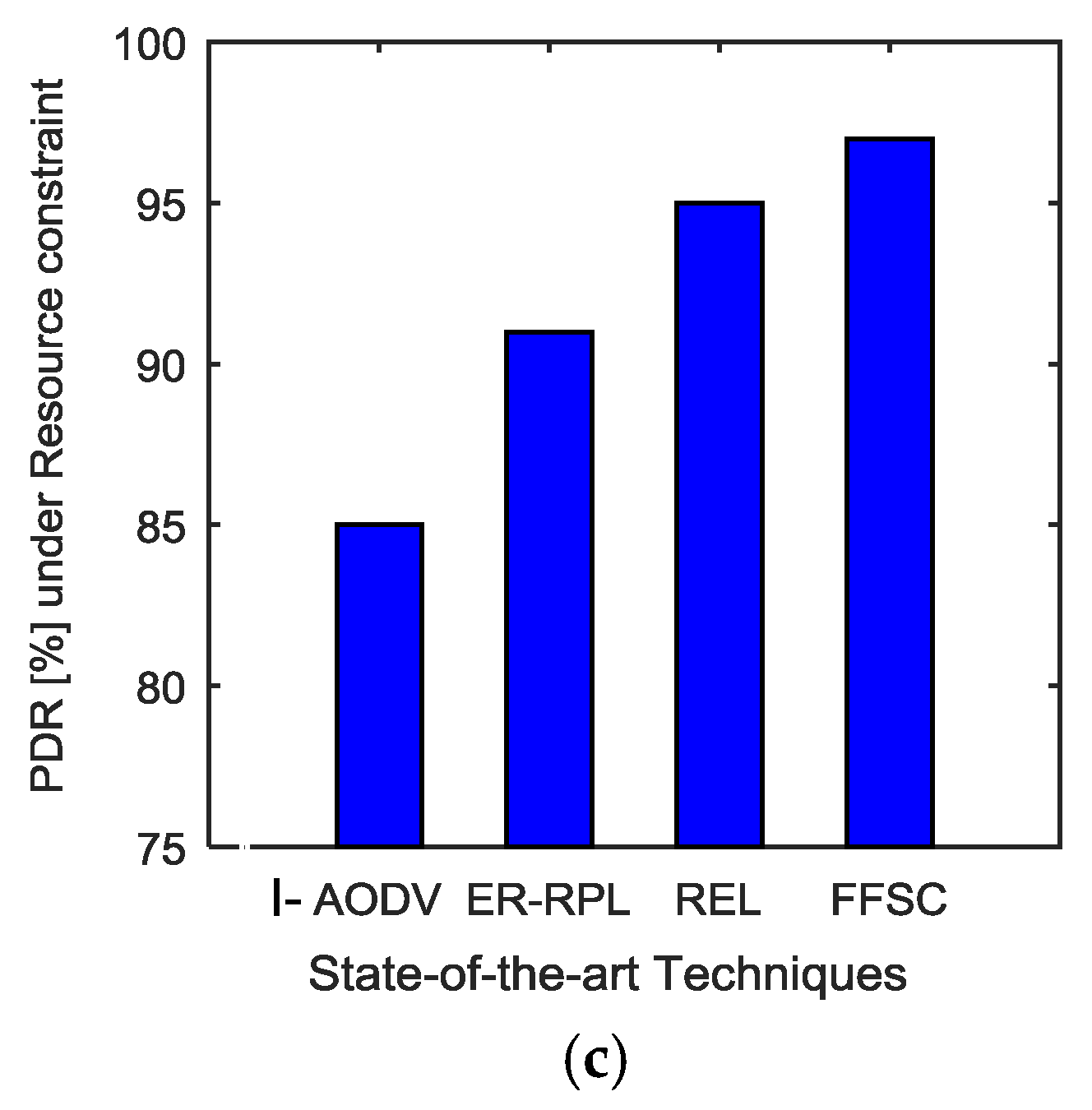
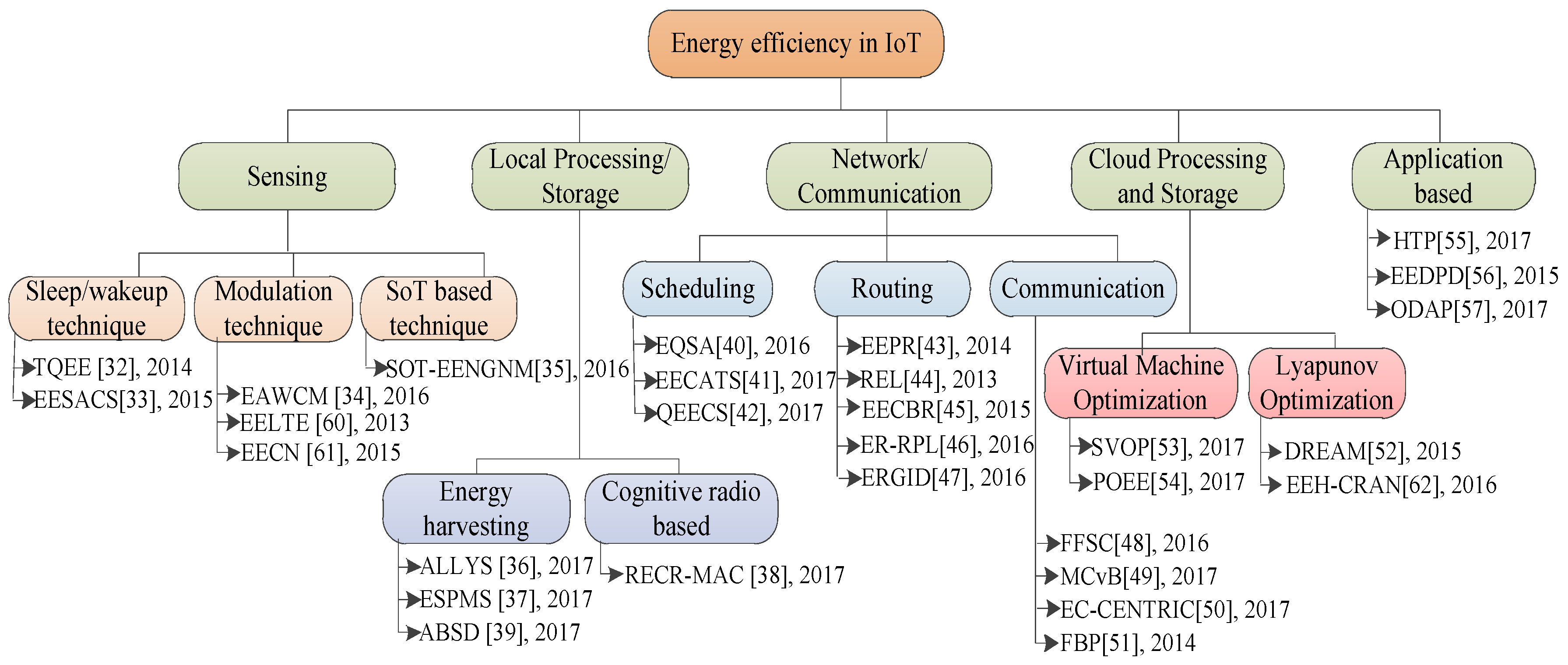

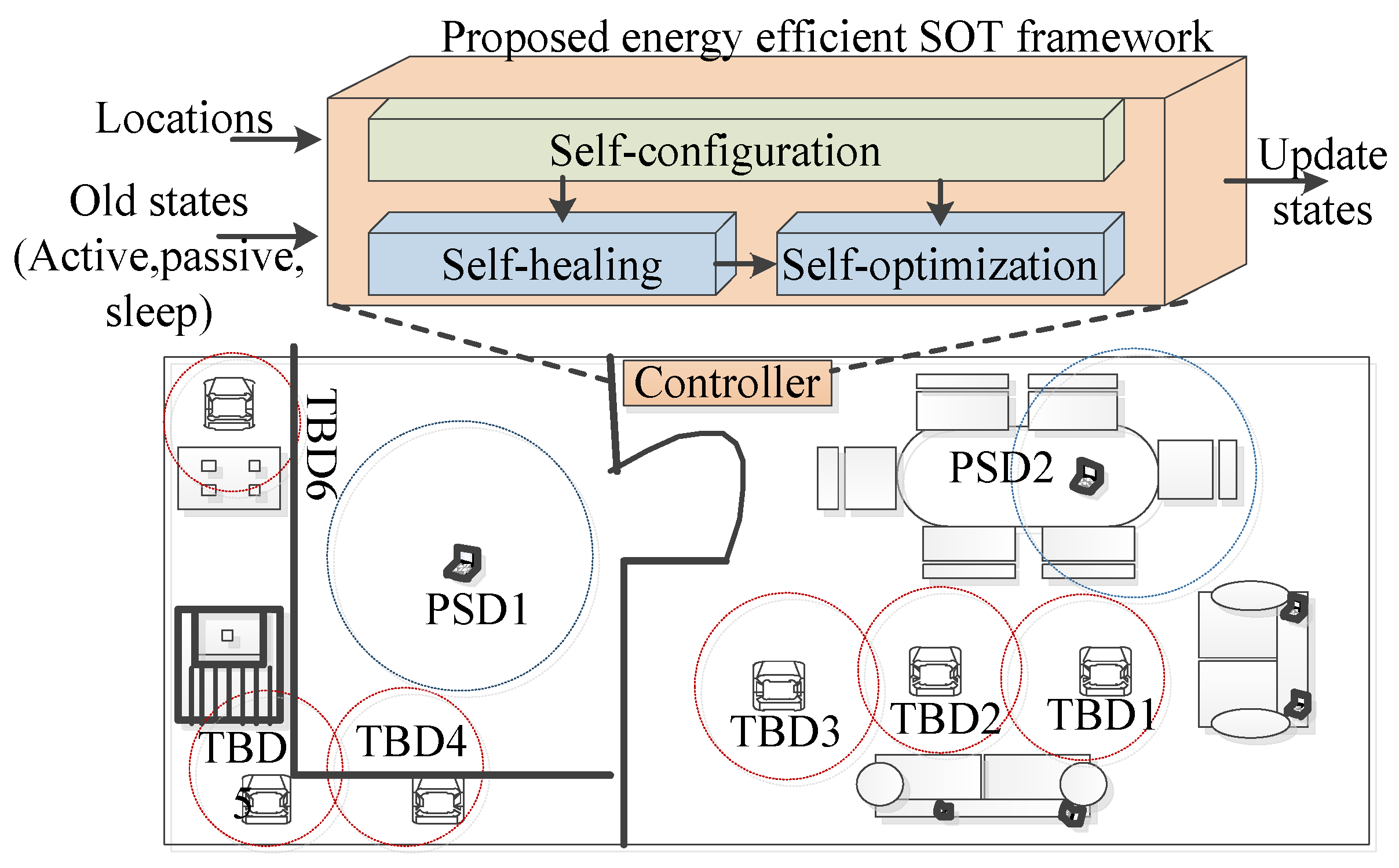


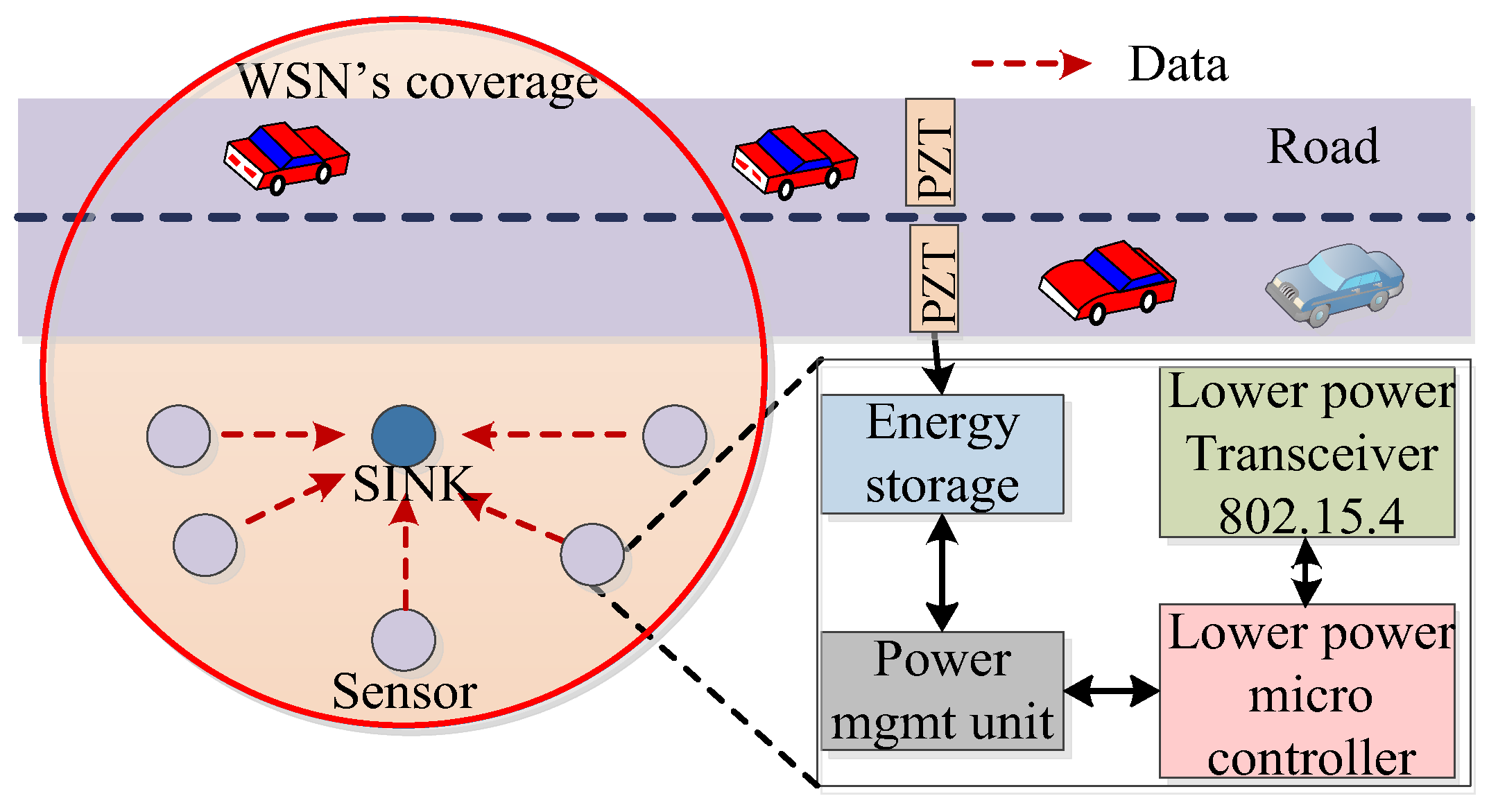
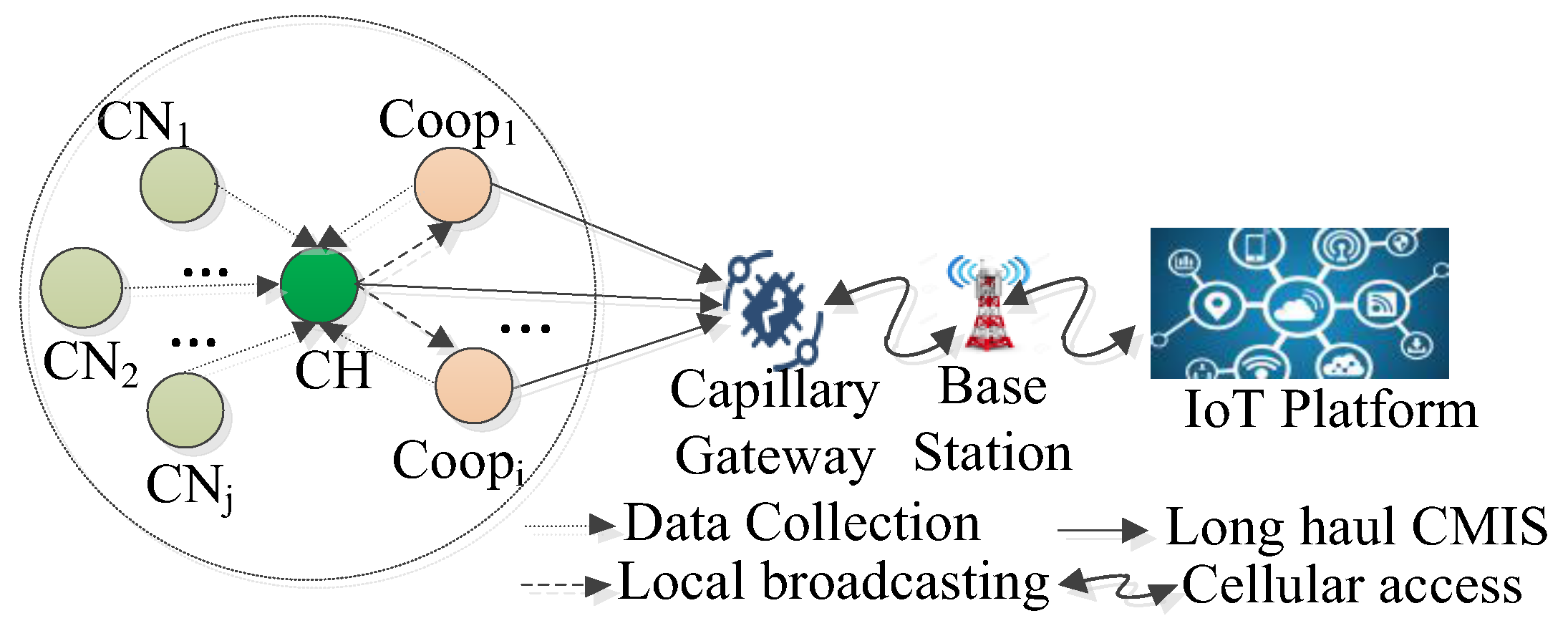
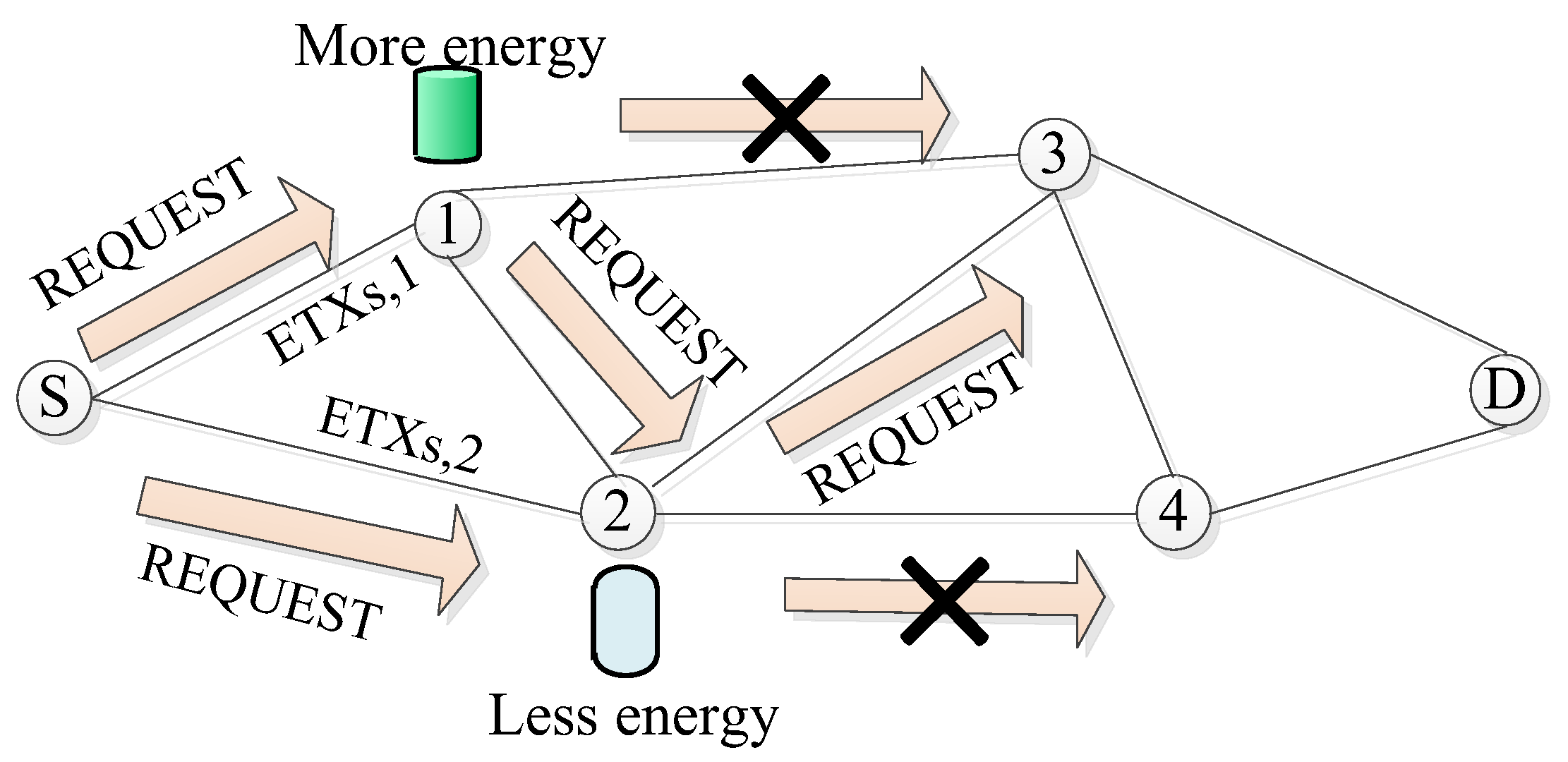

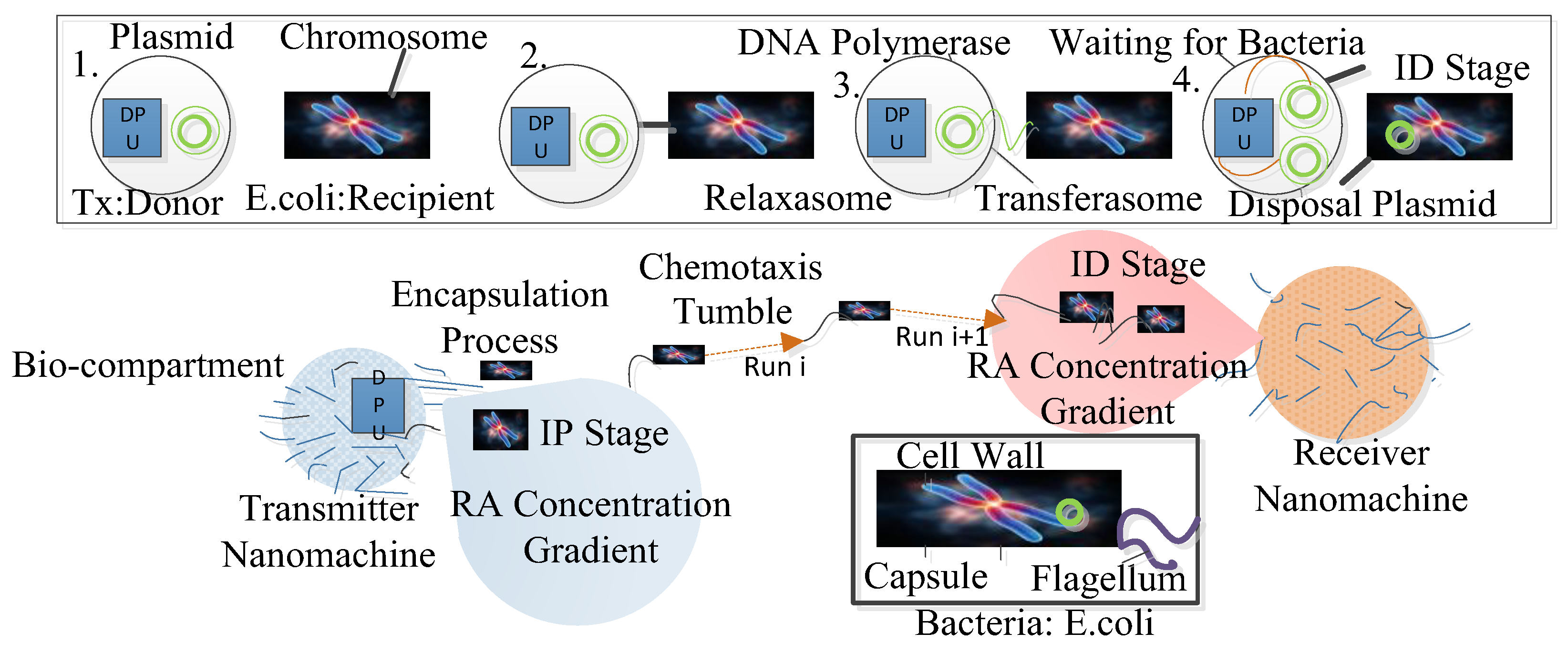


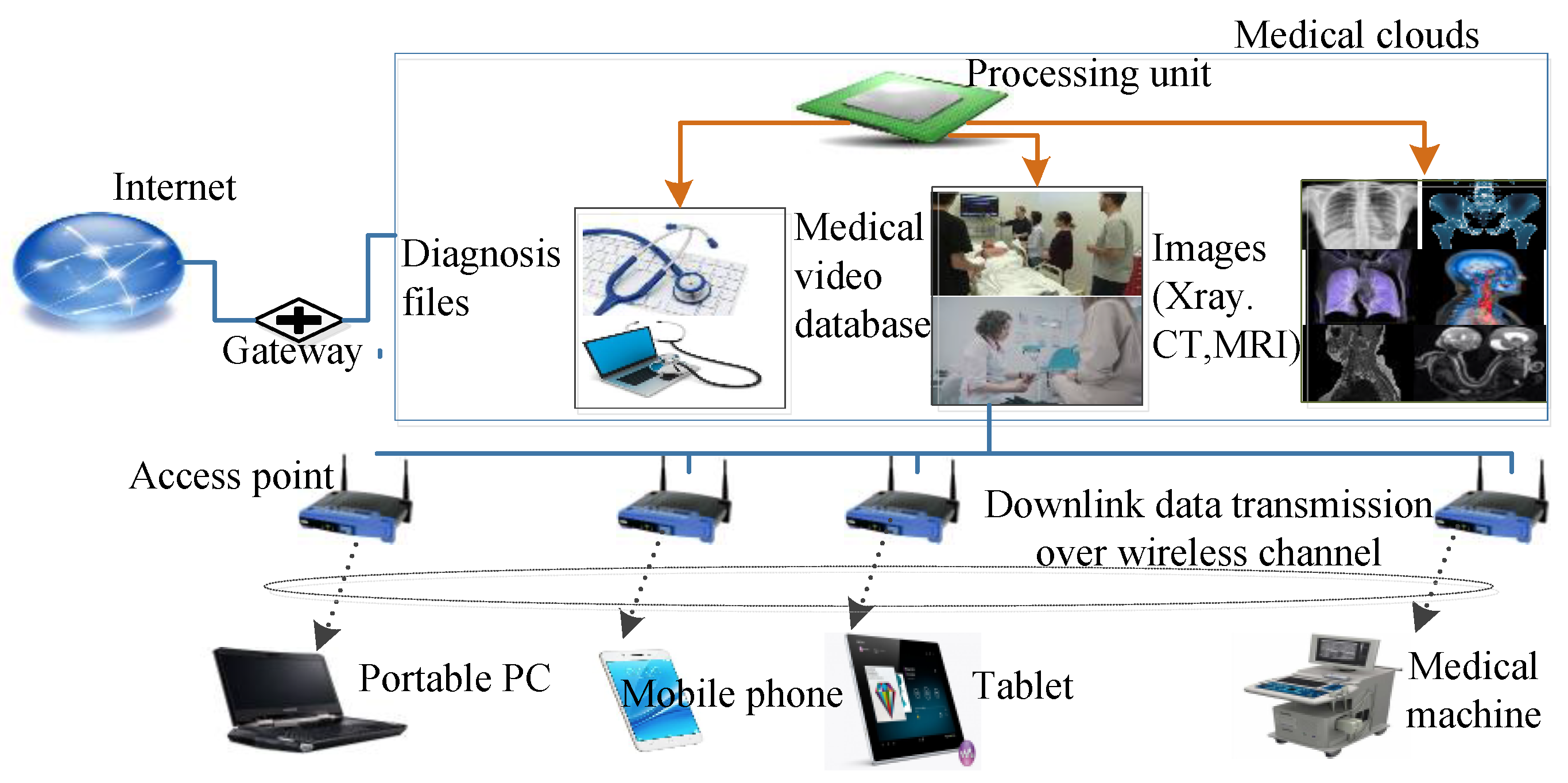
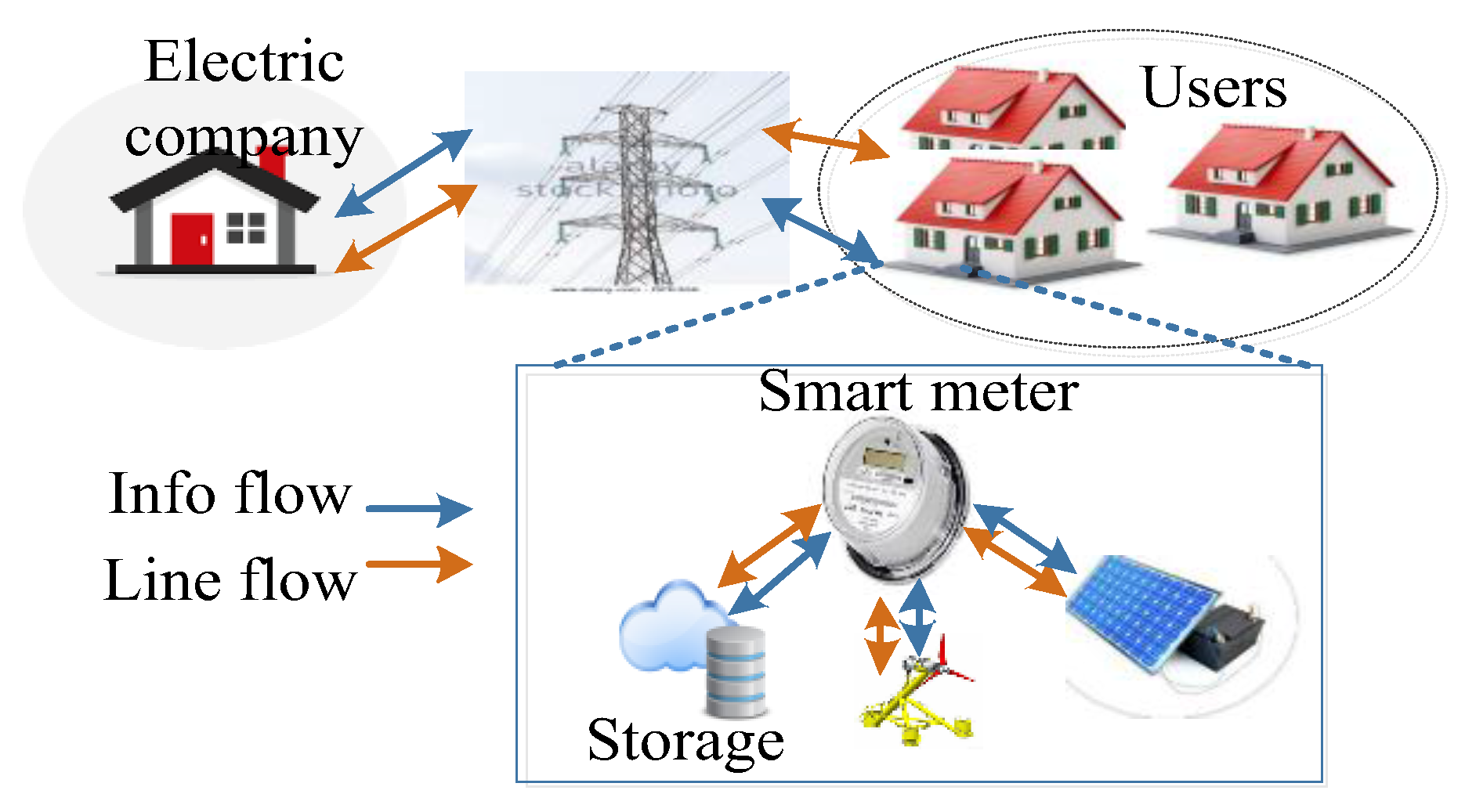
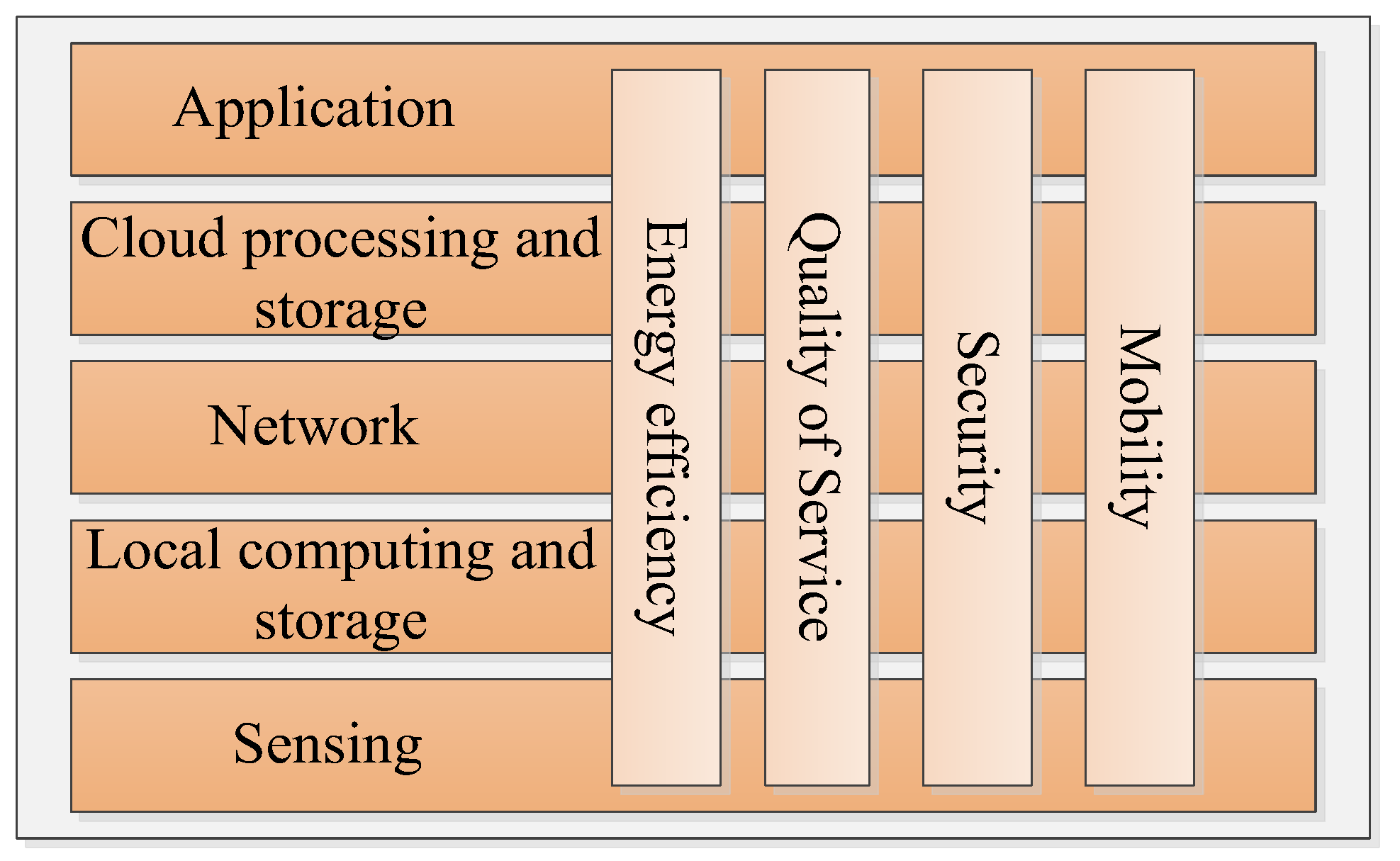
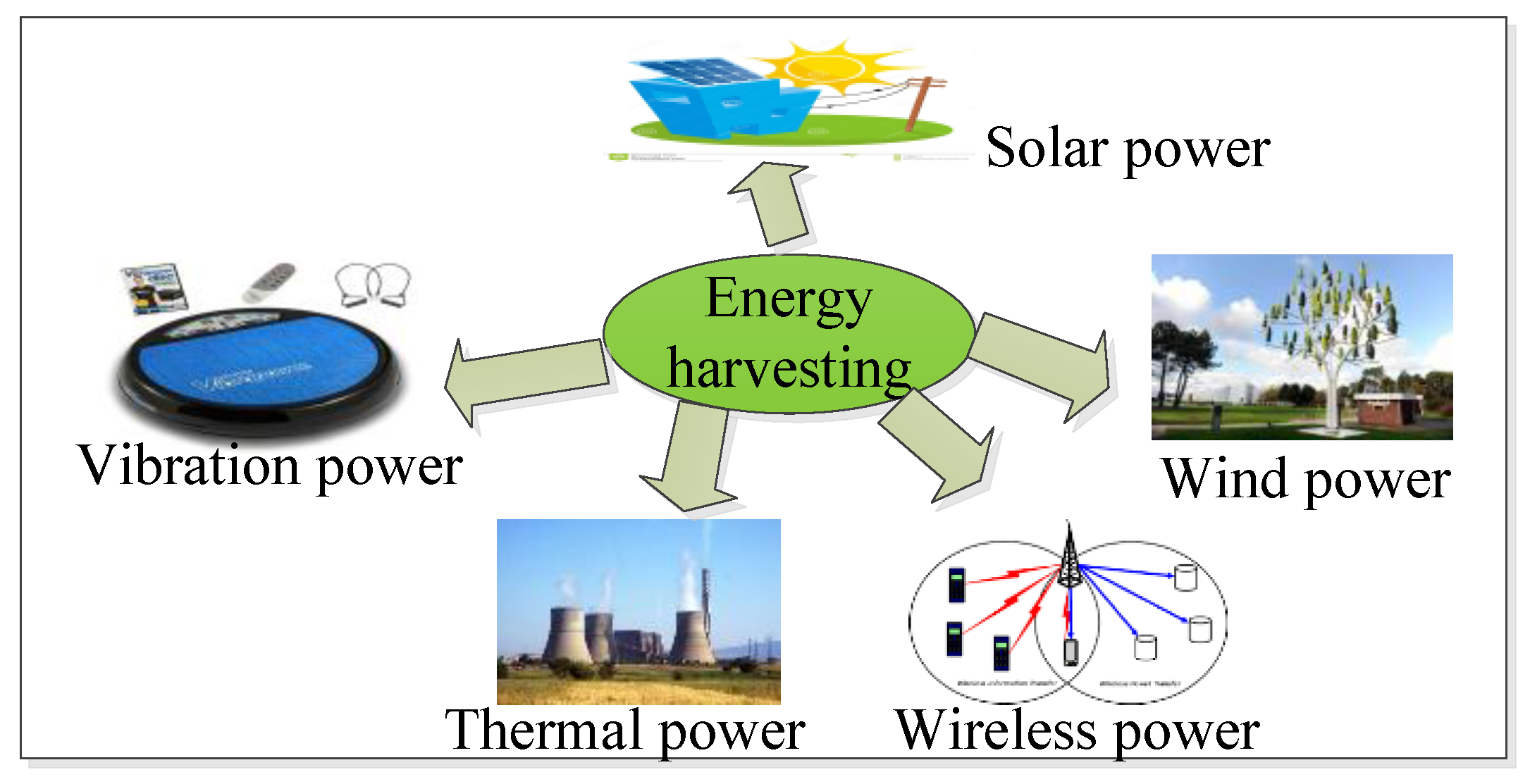
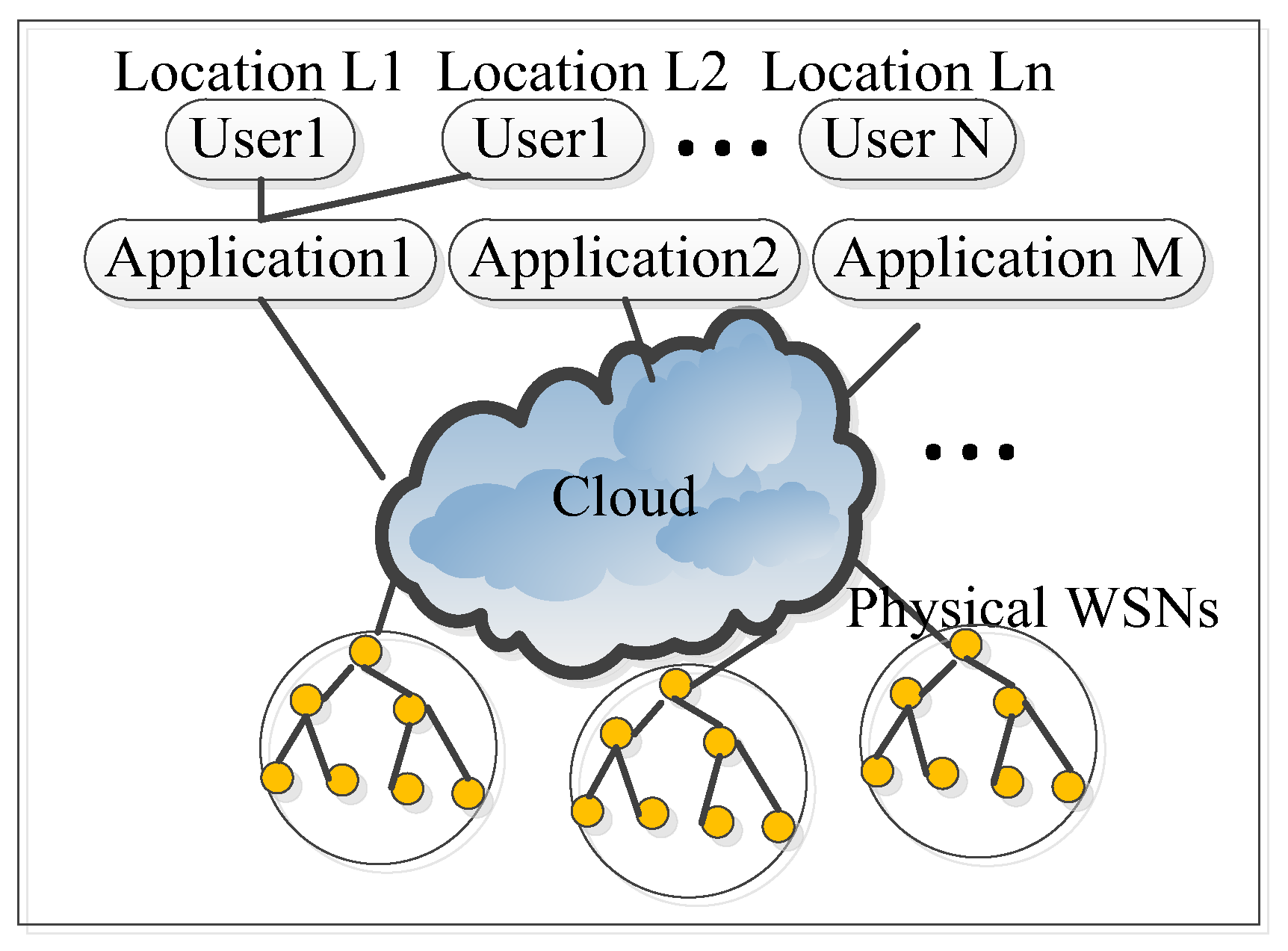
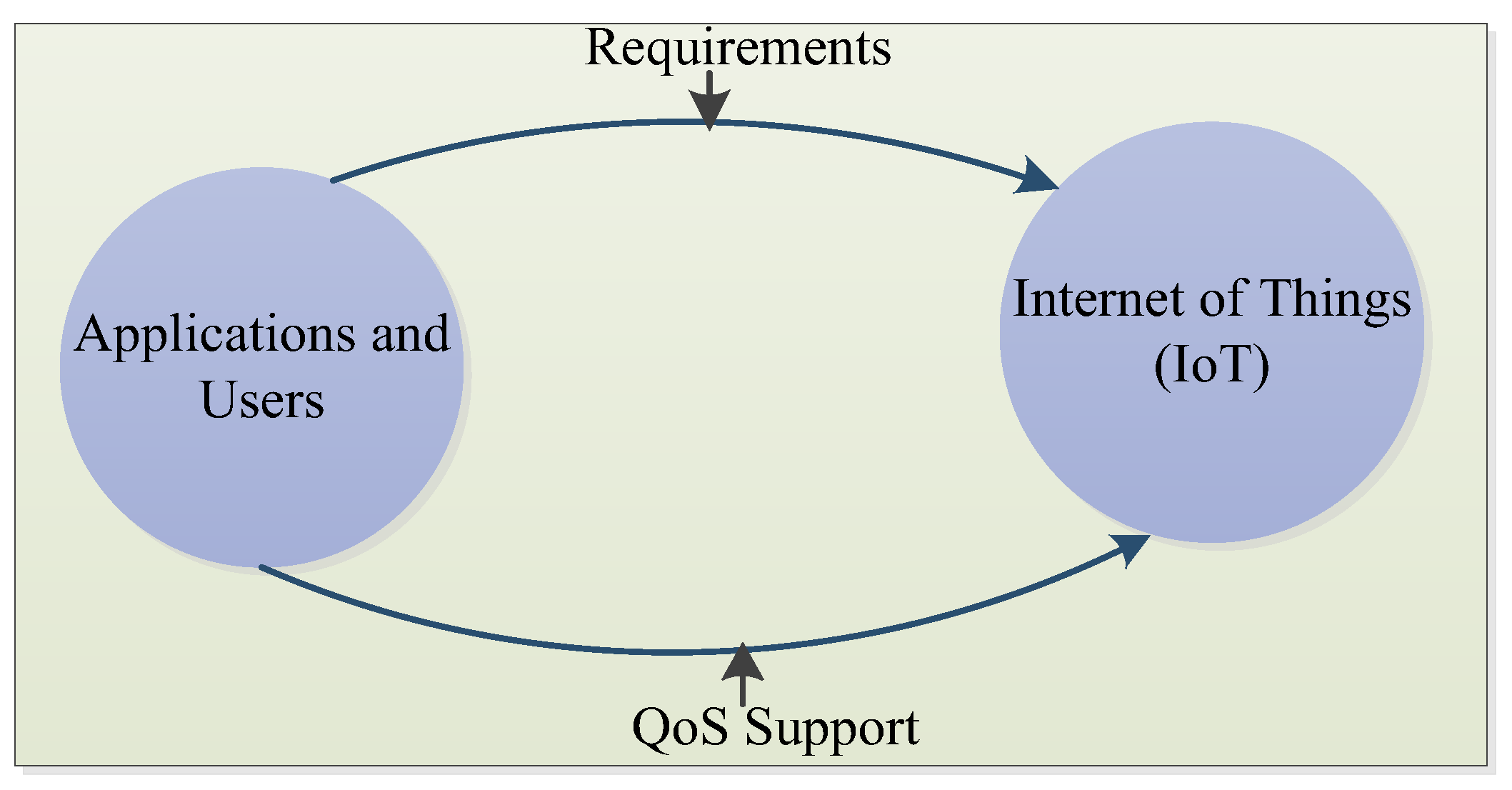
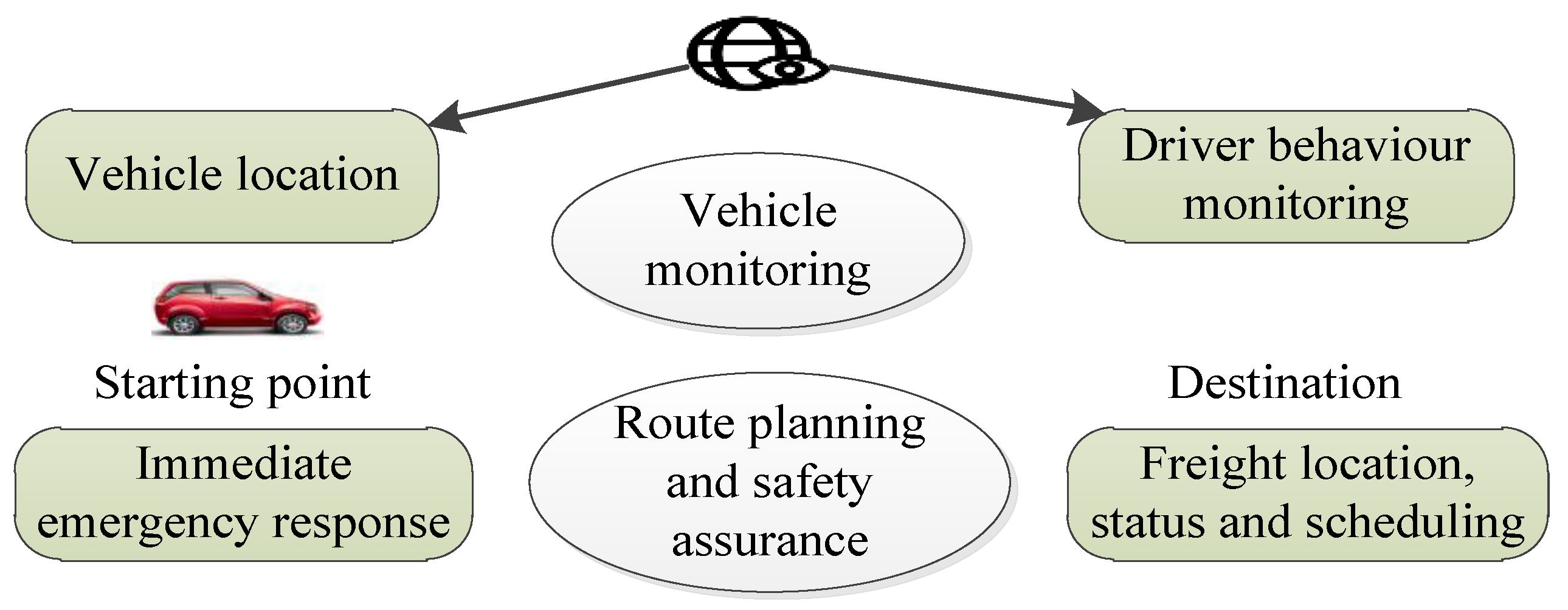
| Parameters | Values |
|---|---|
| Simulation area | 100 m × 100 m |
| Simulation time | 70 m |
| Number of Nodes | 500 |
| Topology | random |
| Initial Energy | 18,535 J (2 AA batteries) |
| Power for transmission | 0511 W |
| Power for reception | 0588 W |
| Base station Location | (60, 60) |
| Transmission range | 0.2 m |
| Transmission limit | 5 |
| The radius of network | Source and destination specific |
| The traffic rate | 3 p/s |
| Notation | Description |
|---|---|
| Sensing capability of sensor n | |
| Desired QoI of task m | |
| Sensory radius | |
| Variance for sensor n | |
| Accuracy requirement of task m | |
| Sensor-task relevancy function | |
| Maximum residual energy of all possible subset of m activated sensors | |
| Normalized residual energy of sensor | |
| Energy per information bit | |
| System data rate | |
| Total energy utilization of the network at time t | |
| Actual coverage area | |
| Active sensors quantity at time t | |
| Probability of harvesting k energy units during T time slots of a frame | |
| Amount of harvested energy of a node during a frame | |
| Average harvested energy | |
| Energy consumption by sensor node | |
| Energy consumed to operate electrical circuit in the sensor node | |
| Relative dominance of candidate service | |
| Total energy spent in awake state | |
| Outage probability | |
| Maximum outage probability threshold | |
| Lifetime of a node | |
| Forwarding probability of a node | |
| Residual energy of node i | |
| Maximum residual energy of node i | |
| Energy threshold | |
| Traffic generation rate at node | |
| Traffic arrival rate at node | |
| Traffic departure rate from node to node | |
| Delay between two node x and y | |
| Iterative delay | |
| Expected delay of node | |
| Total delay of entire network | |
| Energy consumption of a node X distance away from the sink | |
| Total energy consumption in entire network | |
| Energy cost of a component | |
| Energy consumption of a device | |
| Lagrangian function of optimization problem | |
| End to end reliability | |
| Lifetime of whole network under HTP technique | |
| Welfare of every user | |
| Utility function of user | |
| Conflict parameter |
| Abbreviation | Description | Abbreviation | Description |
|---|---|---|---|
| CL | Cross-layer | PCV | Photovoltaic cell voltage |
| CA | Context aware | PDR | Packet delivery ratio |
| DL | Delay | CLT | Clustering |
| EC | Energy consumption | ETX | Expected transmission count |
| EE | Energy efficiency | BU | Bandwidth Usage |
| DB | Durability | LQ | Link quality |
| CS | Compressive sensing | EH | Energy harvesting |
| NL | Network lifetime | OP | Outage probability |
| MAC | Medium access control | RD | Relative dominance |
| CPL | Composite lifetime | OPM | Optimality |
| DC | Duty cycle | ST | Selection time |
| ND | Network distortion | THP | Throughput |
| ACA | Actual coverage area | L-Ratio | Largest energy cost ratio |
| DPR | Droped packet ratio | PLR | Packet loss rate |
| QoS | Quality of service | T-Ratio | Total saved energy cost ratio |
| CP | Conflict parameter | CO | Control overhead |
| QoI | Quality of information | HC | Hop count |
| NDIB | Number of delivered information bits | PD | Processing density |
| EUS | Energy used per server | AR | Acceptance rate |
| NoM | Number of migrations | PC | Power consumption |
| CU | CPU utilization | PAR | Peak to average ratio |
| GL SOT | Grid loading Self-Organized Things | GV | Grid variance |
| Characteristics | Issues | Contributions | Techniques | Simulators | Metrics | Limitations | |
|---|---|---|---|---|---|---|---|
| Protocols | |||||||
| TQEE | Energy and data quality management | Energy efficient and QoI based solution | QoI-aware sensor-to-task relevancy using duty cycle | Matlab | -DL -QoI -EE | Limited to static environment | |
| EESAC | Problem of more energy consumption and less robustness because of pipeline leakages | Energy efficient and Robust solution | Compressive sensing based scheduling approach | EPANET | -NL -EE | Not applicable to applications like monitoring of tunnels and railways | |
| EAWCM | Energy optimization because of unique system constraint by ultra-small system dimension | Energy optimized solution. | Cross layer system level optimization approach | -- | -EE -DR -PER -SNR | Error correction has not been considered. | |
| SOT-EENGNM | More human-device interaction and Energy efficiency | Energy optimized, Durable and self-managed solution | Self-Organized Things based technique | -- | -ACA -CP -EE -DR | Parameters such as Delay, Link stability have not been considered. | |
| Protocol/Author | Approaches | Metrics | ||||||||||||
|---|---|---|---|---|---|---|---|---|---|---|---|---|---|---|
| QoI | CS | CL | DC | SoT | DL | EE | DR | SNR | NL | CP | ACA | PER | DB | |
| TQEE [32] | √ | √ | √ | √ | ||||||||||
| EESAC [33] | √ | √ | √ | √ | ||||||||||
| EAWCM [34] | √ | √ | √ | √ | √ | √ | ||||||||
| SOT-EENGNM [35] | √ | √ | √ | √ | √ | √ | √ | |||||||
| Characteristics | Issues | Contributions | Techniques | Simulators | Metrics | Limitations | |
|---|---|---|---|---|---|---|---|
| Protocols | |||||||
| ALLYS | Wastage of energy in idle, listening, overhearing, collision and retransmissions | Limited battery solution | Energy harvesting and frame slotted aloha technique | Qualnet and VanetMobiSim | -DL -EE -THP | -- | |
| ESPMS | Energy limitation | Utilization of stored energy in regulation and insufficient energy to maintain load | Solar energy harvesting technique | 0.18-μm CMOS, MOSFET | -EE -PCV | Parameters such as delay have not been considered | |
| RECR-MAC | Energy consumption and scarcity of bandwidth | Reliable solution with high throughput. | Cognitive Radio Multi-channel MAC approach | NS-2 and SUMO EvalVid | -BU -THP -EE -DR | Not applicable in the applications those are delay sensitive. | |
| ABSD | Excess energy consumption in receiving, transmitting, idle listening and sleeping | Energy efficient and QoS aware solution | MAC aware Energy harvesting approach | OPNET and MatLab | -EE -THP -QoS -DPR | Vital parameters such as PSNR has not been considered. | |
| Protocol/Author | Approaches | Metrics | ||||||||||||
|---|---|---|---|---|---|---|---|---|---|---|---|---|---|---|
| MAC | EH | CR | DC | QoS | DL | EE | QoI | BU | NL | PCV | DR | DPR | THP | |
| ALLYS [36] | √ | √ | √ | √ | √ | √ | √ | |||||||
| ESPMS [37] | √ | √ | √ | |||||||||||
| RECR-MAC [38] | √ | √ | √ | √ | √ | √ | √ | |||||||
| ABSD [39] | √ | √ | √ | √ | √ | √ | √ | √ | √ | |||||
| Characteristics | Issues | Contributions | Techniques | Simulators | Metrics | Limitations | |
|---|---|---|---|---|---|---|---|
| Protocols | |||||||
| EQSA | Energy and QoS aware service selection | Energy and QoS aware solution | lexicographic optimization and QoS constraints relaxation approach | JVM, JRE 1.6 | -EC -QoS -CPL -OPM -RD -ST | Limited to static environment | |
| EECATS | Dynamic service quality requirement with variable quality information in multi hop communication | Energy and context aware solution | Energy efficient and context aware traffic scheduling | NS2 and Contiki OS | -EE -DL -DR -THP -CA | Overload and link quality have not been considered | |
| QEECS | Maintain tradeoff between energy consumption and QoS. | Energy efficient Qos aware solution for industrial applications | QPSO, TDMA scheduling, NSGA-2 | MATLAB | -EE -NL -OP -QoS | Delay is not considered. Analysis of the clustering performance is not performed. | |
| Protocol/Author | Approaches | Metrics | ||||||||||||
|---|---|---|---|---|---|---|---|---|---|---|---|---|---|---|
| MAC | CLT | CA | DC | QoS | DL | EE | OPM | RD | NL | OP | DR | CPL | THP | |
| EQSA [40] | √ | √ | √ | √ | √ | √ | √ | |||||||
| EECATS [41] | √ | √ | √ | √ | √ | √ | √ | √ | ||||||
| QEECS [42] | √ | √ | √ | √ | √ | √ | √ | |||||||
| Characteristics | Issues | Contributions | Techniques | Simulators | Metrics | Limitations | |
|---|---|---|---|---|---|---|---|
| Protocols | |||||||
| EEPR | Network partitioning and Energy consumption in distributed network | Evenly consumption of energy by each node and enhanced network lifetime | Energy efficient probabilistic routing | NS-2 on Linux fedora 13 | -ETX -EE -LQ -NL | Delay is not considered. Routing success probability is less and route setup delay is high | |
| REL | Restriction of sensor nodes in terms of energy, processing and memory. | Evenly distribution of network resources, enhanced lifetime and QoS | Routing protocol based on energy and link quality. | OMNET++ with Castalia framework | -EE -LQ -HC -NL -PDR -DL | Not managed radio/transmissions to improve energy saving | |
| EECBR | Energy consumption challenge in asynchronous communication | Enhanced lifetime and less energy consumption | Publish/subscribe scheme based on content based routing | OMNET++ | -EE -NL | QoS parameter such as delay is not considered. Cross layer approach is not utilized | |
| ER-RPL | Energy efficiency, reliability, dead zone problem | Energy efficient, reliable and robust solution. | Distributed self-regioning technique | NS-3 | -DL -PDR -EC -HC -CO | Not working in dynamic environment. | |
| ERGID | Assurance of real time emergency response ability | Reliable data transmission and energy efficient emergency response in IoT | Emergency response IoT based on global information decision. REPC and DIM | NS-2 | -DL -EE -PLR | Limited to small-scale emergency response IoT for energy consumption | |
| Protocol/Author | Approaches | Metrics | ||||||||||||
|---|---|---|---|---|---|---|---|---|---|---|---|---|---|---|
| SR | PA | PSS | CA | QoS | DL | EE | LQ | ETX | NL | HC | PLR | PDR | CO | |
| EEPR [43] | √ | √ | √ | √ | √ | |||||||||
| REL [44] | √ | √ | √ | √ | √ | √ | √ | √ | ||||||
| EECBR [45] | √ | √ | √ | |||||||||||
| ER-RPL [46] | √ | √ | √ | √ | √ | √ | √ | √ | ||||||
| ERGID [47] | √ | √ | √ | √ | ||||||||||
| Characteristics | Issues | Contributions | Techniques | Simulators | Metrics | Limitations | |
|---|---|---|---|---|---|---|---|
| Protocols | |||||||
| FFSC | Maintain tradeoff between energy efficiency and delay | Energy efficient solution with minimized delay | Fast data collection for node Farthest away from the sink and Slow data collection for node Closest to the Sink technique, | OMNET++ | -EE -DL -NL | Link quality has not been considered | |
| MCvB | Low capacity, more delay and sensitivity to environmental parameters via deffusion | Superior energy efficiency for long distance and delay sensitive communication | Bacteria mobile relay technique | -- | -EE -NDIB -DR | Inferior Energy efficiency in short distance and delay tolerant communication. | |
| EC-CENTRIC | Ill design network, processing and resource management solution | Energy efficiency in dynamic environment | Energy centric and context aware optimization technique | -- | -NL -ND -QoS | Functionalities such as Energy harvesting, wakeup radios and protocol adaptation have not been considered | |
| FBP | Communication energy cost | Less computation time and energy cost | Maximum weight independent set approach based on clustering | -- | -T-Ratio -L-Ratio | Vital parameters such as Delay, link quality have not been considered. | |
| Protocol/Author | Approaches | Metrics | ||||||||||||
|---|---|---|---|---|---|---|---|---|---|---|---|---|---|---|
| MAC | BMR | DC | CA | CLT | DL | EE | T-Ratio | L-Ratio | NL | ND | NDIB | DR | QoS | |
| FFSC [48] | √ | √ | √ | √ | ||||||||||
| MCvB [49] | √ | √ | √ | √ | √ | √ | ||||||||
| EC-CENTRIC [50] | √ | √ | √ | √ | √ | √ | √ | |||||||
| FBP [51] | √ | √ | √ | √ | ||||||||||
| Characteristics | Issues | Contributions | Techniques | Simulators | Metrics | Limitations | |
|---|---|---|---|---|---|---|---|
| Protocols | |||||||
| DREAM | Increasing cpu and energy consumption in mobile device | Energy efficient and fairly scheduled solution with less delay | Lyapunov optimization technique | Android phone (Galaxy note2) | -DL -EE -PD | Recorded video streaming has not been evaluated | |
| SVOP | High cloud provider cost and energy consumption | Consolidation based energy efficient and robust solution | Smart virtual machine over provision technique | VanetMobiSim | -EUS -AR -NoM | Less acceptation rate | |
| POEE | Challenge to balance system performance and power consumption | Energy efficient and adaptive solution | Predictive and convex optimization technique | NS-2 and SUMO EvalVid | -PC -DL -CU | Limited to homogenous environment and not suitable in real life scenarios | |
| Protocol/Author | Approaches | Metrics | |||||||||||
|---|---|---|---|---|---|---|---|---|---|---|---|---|---|
| SVM | LO | PO | QoS | CLT | DL | EE | PD | EUS | AR | PC | CU | NoM | |
| DREAM [52] | √ | √ | √ | √ | √ | ||||||||
| SVOP [53] | √ | √ | √ | √ | √ | √ | √ | ||||||
| POEE [54] | √ | √ | √ | √ | √ | √ | |||||||
| Characteristics | Issues | Contributions | Techniques | Simulators | Metrics | Limitations | |
|---|---|---|---|---|---|---|---|
| Protocols | |||||||
| HTP | Energy consumption, delay and reliabilty | Green and reliable communication | send-wait automatic repeat request and network coding based redundant transmission techniques | OMNET++ | -DL -EC -NL -PDR -LLR | Bad performance in case of small link loss rate | |
| EEDPD | Problem of buffer stabilization and energy efficiency | Reliable, robust and energy efficient solution | Energy efficient dynamic allocation technique | NS-2 | -EE -NL | Quality awareness has not been considered. | |
| OPAD | Evenly distributed energy consumption | Scalable, energy efficient solution. | Renewable energy buying back and day ahead time dependent pricing techniques | NS-2 and SUMO EvalVid | -EE -GL -GV -PAR | Vital parameters such as delay and Quality awareness have not been considered | |
© 2017 by the authors. Licensee MDPI, Basel, Switzerland. This article is an open access article distributed under the terms and conditions of the Creative Commons Attribution (CC BY) license (http://creativecommons.org/licenses/by/4.0/).
Share and Cite
Kumar, K.; Kumar, S.; Kaiwartya, O.; Cao, Y.; Lloret, J.; Aslam, N. Cross-Layer Energy Optimization for IoT Environments: Technical Advances and Opportunities. Energies 2017, 10, 2073. https://doi.org/10.3390/en10122073
Kumar K, Kumar S, Kaiwartya O, Cao Y, Lloret J, Aslam N. Cross-Layer Energy Optimization for IoT Environments: Technical Advances and Opportunities. Energies. 2017; 10(12):2073. https://doi.org/10.3390/en10122073
Chicago/Turabian StyleKumar, Kirshna, Sushil Kumar, Omprakash Kaiwartya, Yue Cao, Jaime Lloret, and Nauman Aslam. 2017. "Cross-Layer Energy Optimization for IoT Environments: Technical Advances and Opportunities" Energies 10, no. 12: 2073. https://doi.org/10.3390/en10122073





